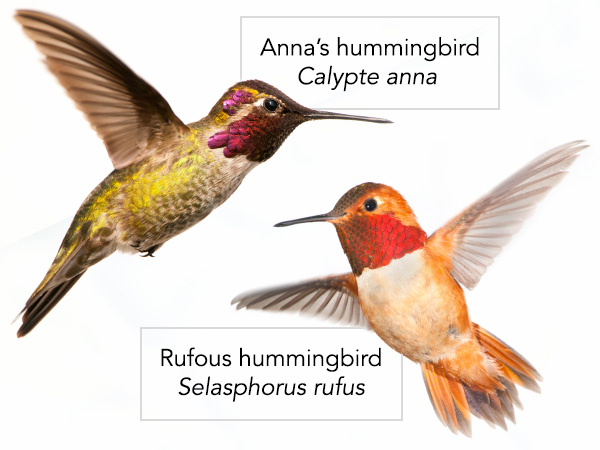 Currently shopping at
Renton
Currently shopping at
Renton

6 Plants That Attract Hummingbirds
One can buy mason bees, purchase the proverbial can of worms—heck we even sell nematodes at McLendon’s. But if your heart desires hummingbirds, the only thing to do is plant strategically, provide a feeder in winter and pray.
Prayers for hummingbirds rarely go unheeded in Western Washington. We're the home, and the home-away-from-home, for two different species and both are hungry.
Rufous hummingbirds Selasphorus rufus are migratory and arrive around April or May. They follow the bloom-time of native plants from Central and South America to Washington State and beyond. Anna’s hummingbirds Calypte annaoverwinter in trees and shrubs in our region and are especially appreciative of winter feeding.
A hummingbird’s metabolism works so fast that it risks starvation on a nearly daily basis. Every single one is constantly looking for reliable food sources. Nectar, the sweet secretion from plants, contains sucrose, glucose and carbohydrates and provides the calories the birds need to survive. Spiders and insects make up the rest of their diet and provide protein and other nutrients.

Only two species of hummingbirds are seen in Western Washington.
To bring hummingbirds to your garden, plant nectar-rich flowering plants, preferably with long, tubular flowers and ones which can be shorn back for more blooms later in the season. The longer your garden blooms, the more hummers you'll see. Now let's get growing, gardeners!

BEE BALM
Monarda didyma
Mint to Bee Friends
The native North American bee balm is a homegrown favorite of hummingbirds. Whorls of bright, tubular flowers resembling sea anemones lure pollinators from far and wide. The mint family Lamiacaes perennial blooms from spring until fall. When brushed, the leaves emit a spicy aroma of minty basil.
GROWING GUIDE: Plant bee balm in a sunny location that can be kept consistently moist. Drying out repeatedly can kill it in just a few years. Snip off flowers as they fade to encourage continuous blooming. Use your fingertips to pinch the stem off at the next set of leaves. Pinching also forces the plant into a more pleasing, bushy shape.

SAGE
Salvia spp.
Shearly You Jest
It’s no joke—over 100 species of sage attract hummingbirds to the garden. The sparse spikes of pineapple sage S. elegans would look at home on the prairie. Common sage S. officinalis is a staple in any herb garden and produces dense purple spikes if left unpruned. And the fiery, fleshy stem of S. splendens(pictured) may just inspire its moniker, scarlet sage.
GROWING GUIDE: Plant in full sun, or some afternoon shade. While salvia is extremely drought-tolerant, be sure to settle in new plants the first year with regular watering. You can get 2–3 crops of flowers from spring to fall be shearing the plant back by a third after blooming.

CROCOSMIA
Crocosmia spp.
Corm Back For Me
Crocosmia, in smaller forms called Montbretia, is one of late-summer’s brightest delights. Exotic reds and oranges bloom on angled flower spikes creating swaths of color that are impervious to the heat. As other flowering plants succumb to the swelter, crocosmia goes right on blooming.
GROWING GUIDE: Flowers best in full sun. Plant corms in spring, or mature plants any time before fall. Corms are swollen stems, thick with stored nutrients. They lack the scales that make a true bulb, so after the first frost kills the foliage use a pitchfork or shovel to remove the corms in clumps. Store them, soil and all, in a cool place until spring.

FUCHSIA ‘GARTENMEISTER BONSTEDT’
Fuchsia triphylla mult.
Nectar Loud, Trumpet Proud!
Gartenmeister fuchsia, a.k.a. upright fuchsia, honeysuckle fuchsia and sometimes sold as F. ‘Thalia,’ is my most reliable hummingbird attractor. Its frilly, fuchsia-basket cousins are bred for double skirts and candy colors—not nectar. F. triphylla has long, trumpet-shaped flowers in bright red-orange and thrives in the heat. A basket in a bright location, with plenty of fertilizer, can bloom on and on till first frost.
GROWING GUIDE: Plant densely in a coco-lined basket and hang in a sunny location. I know! It sounds scary…a fuchsia in direct sunlight. But Gartenmeister fuchsias are one of the few that can thrive in the sun.

BEARD TONGUE
Penstemon spp.
Happy High ‘n Dry
At home in rock gardens, prairies and arid locales, Penstemon offer hummers everything they love—large, tubular flowers, a familiar taste (it's native to North America) and a long bloom-time. From spring to fall, and sometimes beyond, open-mouthed flowers add vibrant color to border gardens, while going easy on the water bill.
GROWING GUIDE: Plant in full sun or part shade. Provide well-draining soil. If your soil is more clay-like, incorporate compost, sand and/or soil conditioner first. Give your planting limited or no extra water, unless otherwise noted. Deadhead continuously to encourage flowering late into the season.

HUMMINGBIRD MINT
Agastache spp.
Every Name Smells as Sweet
Another flower with many names and another in the mint family, Agastache is also called Mexican bergamot, anise hyssop, giant hyssop and hummingbird mint. Many of the names allude to its fragrant foliage which produces an aroma like licorice and anise when touched. Short spikes of dense flowers re-bloom continuously when deadheaded.
GROWING GUIDE: Plant in well-draining soil. Many species are native to North America and the southern United States and water-logged locations will quickly kill the desert perennial. Not to fear, Agastache self-seeds! Your only job will be removing seedlings that pop up anywhere inconvenient.




